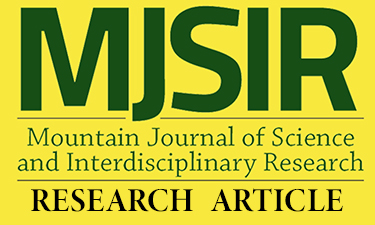Performance of Trichoderma koningii and Bacillus sp. as Potential Biocontrol Agents against Fusarium Wilt (Fusarium oxysporum) of Sweetpotato (Ipomoea batatas)
Main Article Content
Abstract
Fusarium wilt (Fusarium oxysporum) is now becoming a big concern in Cordillera Administrative Region, Philippines affecting different crops including sweetpotato. In effort to help find solution to this problem, the study documented the biological control ability of Trichoderma koningii and Bacillus sp. against Fusarium wilt of sweetpotato through bioassay and pot experiment. Result of the bioassay test in the laboratory showed significant results. The growth of F. oxysporum was inhibited by Benomyl (reference fungicide) and T. koningii. The widest inhibition zone of 29 mm after three days was observed in Benomyl followed by T. koningii with 20 mm. Bacillus sp. gave the least inhibition zone of 3 mm. In the pot experiment, sweetpotato grown in soils amended with T. koningii had the lowest percent infection and lowest severity of diseases. At the end of the cropping season, populations of Bacillus and F. oxysporum decreased while T. koningii increased. The highest reduction of Fusarium spores from 1.8 x 106 to 9.50 x 105 was noted in soils amended with T. koningii, followed by Benomyl from 1.8 x 106 to 1.40 x 105 cfu/ml. Results consistently showed better performance of T. koningii as sole inoculant in inhibiting Fusarium wilt and even better than Benomyl, thus should be encouraged for farmers to adopt.
Article Details
References
Alizadeh, H.R., Sharifi-Tehrani, A., & Hedjaroude, G.A. (2007). Evaluation of the effects of chemical versus biological control on Botrytis cinerea agent of gray mould disease of strawberry. Commun Agric Appl Biol Sci. 72(4):795-800.
Altinok, H.H., & Erdogan, O. (2015). Determination of the in vitro effect of Trichoderma harzianum on phytopathogenic strains of Fusarium oxysporum.
Archita, B. (2018). Biological Control: An Ecofriendly way of Pest Management in Tea. Accessed on good morning science https://gmscience.com
Butt, T., Jackson, C., & Magan, N., (2001). Fungal biological control agents: progress, problems and potential. CAB International. Pp 1:1-2
Chunsheng, X., Zuxia, F., Ruizi, F., Hua, Y., & Nangtong C. (1988). An Evaluation of South China Sweetpotato germplasm for Fusarium wilt resistance. International Potato Center. pp 72-75
Fang-asan, M.L.D., Mula, R.P., Gayao, B.T., Sim, J.M., & Brady, C.H.M. (1998). The dynamics of sweetpotato variety maintenance and planting material management in Bayyo, Mountain Province. In Prain, G. and C. Bagalanon. Conservation and Change in Farmer Management of Agricultural Biodiversity in the Context of Development. UPWARD Los Baños, Laguna. Pp 80-120
Galian, J.L. & Nagpala, A.L., (2006). Effect of different levels of Trichoderma compost as plant growth promoter in garden pea (Pisum sativum L.) BSU Research Journal no. 53 ISSN 0117-5297. Pp. 100-114
Lorezco, T. M., (2004). Management of Fusarium wilt disease of Garden Pea using Trichoderma species. Pp. 10-12. Unpublished Undergraduate Thesis. Benguet State University, La Trinidad, Benguet
Mwanga, R. (2010). Quality Developed Planting Materials, Protocols and Standards for Vegetatively Propagated Crops. FAO Plant Production and Protection Paper
Nagpala, A.L. (1999). Identification and Management of Fusarium oxysporum F. sp. pisi infecting garden pea using Trichoderma spp. Unpublished graduate thesis, UPLB, Laguna, Philippines.Pp. 79-80
Ranasingh, A., Saurabh, A., & Nedunchezhiyan, M. (2006). Use of Trichoderma in Disease Management. Pp 68-70
Raghuchander, T., Jayashree, K., & Samiyappan, R. (1997). Management of Fusarium wilt of banana using antagonistic microorganisms. Journal of Biological Control, 11 : 101– 105.
Sebiano, B. (2015). Trichoderma against Fusarium wilt on sweetpotato. Rangtay Vol. 16. No. 2 Official publication of the Office of Extension Services. Pp. 4
Sarker, A.M., Sultana, N., Islam, M.R., Rashid, M., & Bhuian, Z.R. (2013). Efficacy of some rhizosphere microorganisms in controlling Fusarium wilt of tomato (Lycopersicum esculentum). The Agriculturists. 2013; 11(2):96-103.
Sweetpotato facts and figures. Retrieved from http://www.integratedbreeding.net/770/com munities/…/sweetpotato-facts-figures Accessed on April 7, 2017
Thangavelu, R., Palaniswami, A., Ramakrishnan, G., Doraiswamy, S., Muthukrishnan, S., & Velazhahan, R. (2001). Involvement of Fusaric acid detoxification by Pseudomonas fluorescens strain Pf10 in the biological control of Fusarium wilt of banana caused by Fusarium oxysporum F. sp. cubense. Journal of Plant Disease and Protection, 108 : 433-445.
Tenorio, A.L. & Gonzales, R. (2013). Retrieved from http://docplayer.net. Accessed on April 10, 2017
Ubaub, L.T. & Requina, J.D. (2016). Vesicular Arbuscular Mycorrhizae and Trichoderma harzianum as Biological Control Agents against Panama Disease of ‘Cavendish’ Banana Caused by Fusarium oxysporum F. Sp. Cubense Tropical Race 4. Asian Research Journal of Agriculture 1(2): 1-11
Weller, D.M. (1983). Biological Control of Plant Diseases: Progress and challenges of the future. New York Plenum Press. Pp. 211-222.
Yen, D.E. (1974). The Sweetpotato and oceania: An essay in Ethno-Botany. Bernice T. Bishop Museum Bulletin 236. Bishop Museum Press. Honolulu, Hawaii.Pp. 390
Zaim, S., Bekkar, A.A., & Belabid, L. (2018). Efficacy of Bacillus subtilis and Trichoderma harzianum combination on chickpea Fusarium wilt caused by F. oxysporum F. sp. Ciceris Pp. 217-226

